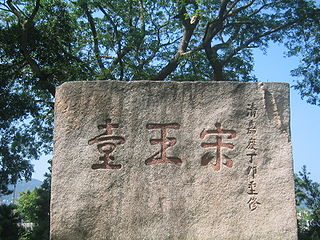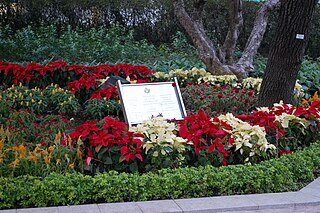
Sung Wong Toi is an important historic relic in Ma Tau Chung, Kowloon, Hong Kong. While its remaining portion is now located in the Sung Wong Toi Garden (宋皇臺花園) at the junction of Ma Tau Chung Road and Sung Wong Toi Road, it was originally a 45-metre-tall boulder standing on the top of Sacred Hill (聖山) in Ma Tau Chung above Kowloon Bay.

The Battle of Hong Kong, also known as the Defence of Hong Kong and the Fall of Hong Kong, was one of the first battles of the Pacific War in World War II. On the same morning as the attack on Pearl Harbor, forces of the Empire of Japan attacked the British Crown colony of Hong Kong around the same time that Japan declared war on Great Britain. The Hong Kong garrison consisted of British, Indian and Canadian units, also the Auxiliary Defence Units and Hong Kong Volunteer Defence Corps (HKVDC).

Ma Tau Wai is an area in the Kowloon City District, Kowloon, Hong Kong. It was originally a walled village between present-day Argyle Street and Prince Edward Road West, east of present-day St. Teresa's Hospital.

Argyle Street is a four-lane dual-way thoroughfare in Kowloon, Hong Kong, connecting the districts of Mong Kok, Ho Man Tin, Ma Tau Wai and Kowloon City. It runs on an east-west alignment starting at its intersection with Cherry Street, Ferry Street and Tong Mi Road in the west, and ending near the former Kai Tak Airport in the east. Due to the street's proximity with the latter, a variety of aircraft could be seen from this street and thus photographers seized the opportunity to capture landing aircraft.

The Imperial Japanese occupation of Hong Kong began when the governor of Hong Kong, Sir Mark Young, surrendered the British Crown colony of Hong Kong to the Empire of Japan on 25 December 1941. His surrender occurred after 18 days of fierce fighting against the Japanese forces that invaded the territory. The occupation lasted for three years and eight months until Japan surrendered at the end of the Second World War. The length of the period later became a metonym of the occupation.

Lai Chi Kok Road is a road in western Kowloon, Hong Kong. It links Lai Chi Kok to Mong Kok, via Tai Kok Tsui, Sham Shui Po and Cheung Sha Wan. It starts from a junction with Nathan Road near Pioneer Centre in the south and ends near Mei Foo Sun Chuen. The road is bidirectional except the section at Lai Chi Kok, between the junction with Butterfly Valley Road and Mei Foo Sun Chuen, where it serves New Territories-bound traffic only. The Kowloon-bound traffic uses Cheung Sha Wan Road, separated by the flyover of Kwai Chung Road. The road once hosted shipyards, fish, meat and vegetable wholesale markets, which were moved closer to the coast after extensive reclamation.

Prince Edward Road East and Prince Edward Road West are roads in Kowloon, Hong Kong, going in an east-west direction and linking Tai Kok Tsui, Mong Kok, Kowloon Tong, Kowloon City and San Po Kong.

Ma Tau Chung is an area in Kowloon, Hong Kong, west of Ma Tau Kok and east of Ma Tau Wai. It was named after a creek which originated in Quarry Hill emptying into Kowloon Bay. The village of Ma Tau Chung stood on its banks near the river mouth near the Sacred Hill.

Sham Shui Po Park is a park in Sham Shui Po, New Kowloon, Hong Kong. It comprises two physically discontiguous sites on either side of Lai Chi Kok Road. The larger site is more well-known as Sham Shui Po Park. The smaller, located within Lai Kok Estate and originally managed by the Housing Authority, became part of Sham Shui Po Park when it was transferred to the Leisure and Cultural Services Department.

Stanley Military Cemetery is a cemetery located near St. Stephen's Beach in Stanley, Hong Kong. Along with the larger Hong Kong Cemetery, it is one of two military cemeteries of the early colonial era, used for the burials of the members of the garrison and their families between 1841 and 1866. There were no further burials here until World War II (1939–1945).
North Point Camp was a Japanese World War II Prisoner-of-war camp in North Point, Hong Kong which primarily held Canadian and Royal Naval prisoners.

Stanley Internment Camp was a civilian internment camp in Hong Kong during the Second World War. Located in Stanley, on the southern end of Hong Kong Island, it was used by the Japanese imperial forces to hold non-Chinese enemy nationals after their victory in the Battle of Hong Kong in December 1941. About 2,800 men, women, and children were held at the non-segregated camp for 44 months from early January 1942 to August 1945 when Japanese forces surrendered. The camp area consisted of St Stephen's College and the grounds of Stanley Prison, excluding the prison itself.

Sham Shui Po Barracks was a British Army facility built in the 1920s in the Sham Shui Po area of Kowloon, Hong Kong. The base was bounded by Fuk Wa Street to the east by Yen Chow Street and to the west by Tonkin Street and Camp Street.

Ma Tau Wai Estate is a public housing estate in Ma Tau Wai, Kowloon, Hong Kong. It is the oldest existing public housing estate in Kowloon City District and it consists of five residential blocks completed in 1962 and 1965. Although it was developed by Hong Kong Housing Authority, it is currently managed by Hong Kong Housing Society.
The following is an overview of public housing estates in Hung Hom, To Kwa Wan and Ma Tau Wai, of Kowloon City District, Hong Kong, including Home Ownership Scheme (HOS), Private Sector Participation Scheme (PSPS), and Tenant Purchase Scheme (TPS) estates.

The following is an overview of public housing estates in Sham Shui Po, Hong Kong, including Home Ownership Scheme (HOS), Private Sector Participation Scheme (PSPS), and Tenants Purchase Scheme (TPS) estates.

Holy Trinity Cathedral, in Kowloon, Hong Kong, is a cathedral for the Anglican Eastern Kowloon diocese. It was established in 1890, making it one of the oldest Anglican churches in Hong Kong. The cathedral is one of the three Anglican cathedrals of the Hong Kong Anglican church.
Douglas James Smyth Crozier, CMG was an Irish teacher, civil servant and the Director of Education of Hong Kong.
Ma Tau Chung Camp was an internment camp in Ma Tau Chung, Hong Kong during the Japanese Occupation of Hong Kong during World War II.















